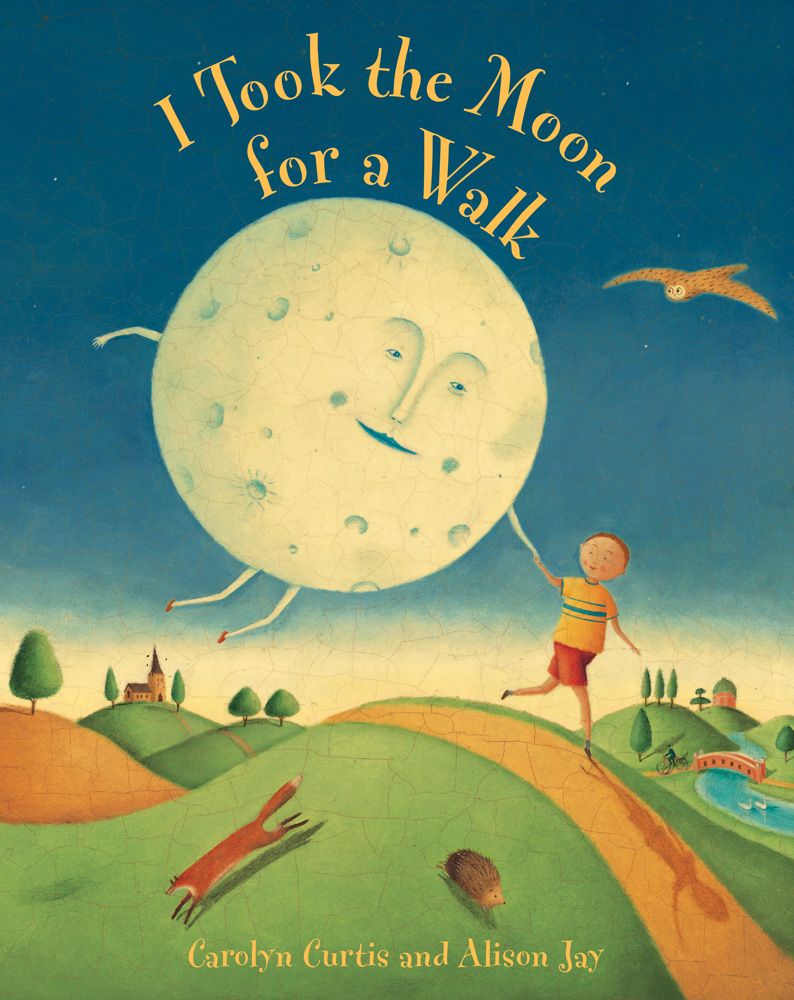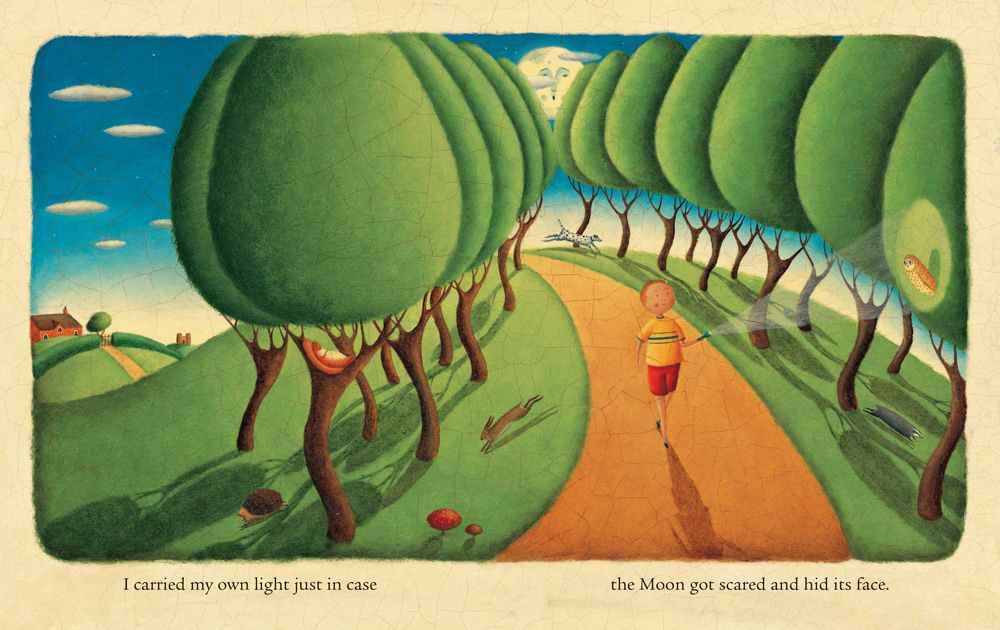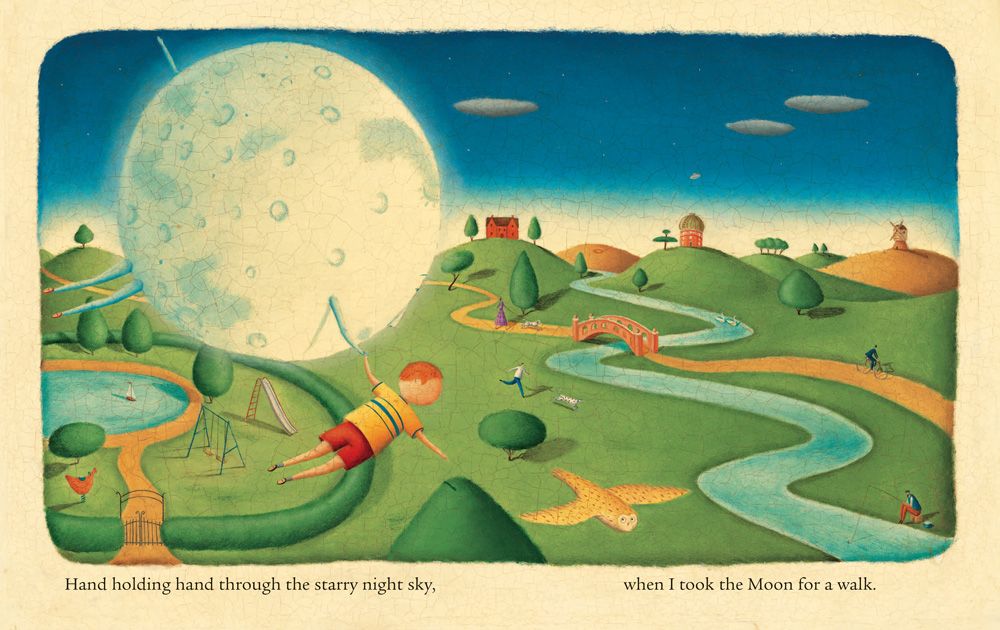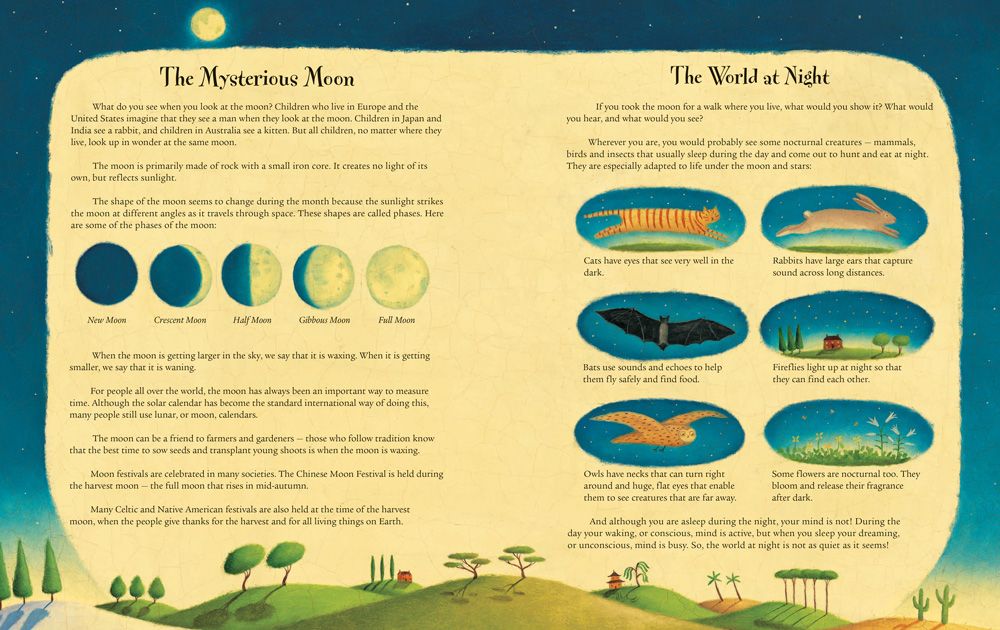This month I wanted to share one of my favorite picture books of all time. I’m embarrassed to say I only discovered the book a few years ago, but immediately fell in love with the magical title, the stunning illustrations and the ingeniously original, lyrical rhyme scheme. On the off chance some of our readers haven’t encountered the book before, here’s a closer look. I’ve become Facebook friends with author Carolyn Curtis-Mahoney (writing as Carolyn Curtis) who makes me laugh nearly every day.
When I Took the Moon for a Walk, written by Carolyn and illustrated by Alison Jay, was originally published by Barefoot Books in 2004. The book has enjoyed a successfully varied life since, appearing in many formats and translations.

Scholastic Parent & Child magazine named I Took the Moon for a Walk one of the 100 Greatest Books for Kids. A parent review on the Barefoot Books website called Moon “a love letter to the twilight hour.” The text has been set to music by several musicians, including Massachusetts singer/songwriter Mark Erelli; it appears on his Little Vigils CD. Some of Alison Jay’s Moon illustrations hang at Boston Children’s Hospital to bring joy to young patients and their families.
I’m very nearsighted, so I’m constantly misreading emails and texts, which means I love the story of how the idea for this book came about. Carolyn, you’ve probably told the story a hundred times, but could you share it one more time, pretty please?
What book parent doesn’t want to talk about the birth of their baby? (Cue nostalgic music and wistful facial expression.) It was my first day of work at a lovely – and extremely busy – non-profit parenting organization. A wall calendar that hung by my desk offered daily suggestions for family-friendly experiences. Looking at the calendar quickly (and probably peering through the first-day stress-sweat pouring down my face), I thought one date said “Take the Moon for a walk with your children.” What a magical idea! Later, looking at the calendar again, I saw it actually said something like “Talk about the Moon with your children.” Now, back then I had pretty good vision – I didn’t have spare readers tucked in every nook and cranny – so I really have no excuse for the misreading, other than the aforementioned stress-sweat. (Round One of Helpful Info, for those not in the know: Readers are magnifying glasses worn on the face. Not nearly so cool as a monocle or Nancy Drew’s sleuthing glass, but much more convenient.) Anyway, this very goofy origin story is a wonderful thing to share with young writers who need to hear that successes can be born out of mistakes, and inspiration is all around us.

I love the soothing repeat line in the book, which you also, brilliantly, used as your opening line even though that line also closes each stanza. (Or very similar words, at least.) Which all strikes me as unique. Since I’m famous for… ahem… borrowing the rhyme schemes of beloved works, did you have a mentor text in mind as you wrote? If not, can you tell us how the structure of the poem evolved?
Did you just say something I did was brilliant? Hold on – I have to show my husband and son. So…I did not have a mentor text in mind. This book – after the gift of the misreading – was truly a gift of mystical inspiration. I love to talk with kids about the word “inspiration” coming from the Latin inspirare meaning “to breathe into.” Sometimes, inspiration really is like that – there’s something miraculous in the air. And, sometimes, you are lucky enough to be the one who gets breathed on. When I felt that breath, I inhaled. Deeply and joyously and gratefully.
I knew I had to write a poem because the notion of taking the Moon for a walk was so poetic, and because of the alliteration and assonance in the words “I took the Moon for a walk.” I heard the rhythm and four-line stanza structure very quickly.
From there, I turned to real life inspiration. When my nephew Christopher was a little boy, he loved to take walks each night with his mom and grandmother. I thought about the things they might experience on their nightly excursions, and then added to those to broaden the adventures.
The repeated line was deliberate for a couple of reasons. It added to the music of the text, and it also invited very young listeners to own and help tell the story. Being able to “read” a story with a loved one, by predicting and joining in on a repeated refrain, is so empowering and encourages early literacy.
I also wanted the story to be circular – beginning and ending at home. Many of the most beloved stories follow the home-away-home structure, which is so satisfying for children. And since Moon opens and closes with basically the same words, I hope children feel the warmth of “welcome in” at the beginning and “welcome home” at the end.
An interesting part of the creation was combining an adventure (with enough different scenes to allow for a variety of illustrations) with what is essentially a bedtime story. Luckily, the active story and the soothing lullaby work together well. And it’s been such a gift to hear that not only have many families made I Took the Moon for a Walk part of their nightly bedtime routine, but they also enjoy taking the Moon for a walk through their own neighborhoods. “Blessed” and “Grateful” are words we see frequently now, on pillows, t-shirts, and Facebook posts, but what better words are there to describe the great joy of knowing that your book has become part of (or even inspired) treasured family traditions? (Contented sigh.)

Everyone loves the backstory to a success story (or, at least, I do!) so can you share your road to publication? Any surprises along the way?
First, I need to recognize the value of critique groups and organizations such as SCBWI. Writing can be a solitary experience, but finding friendship, sharing support, and giving and receiving feedback are all so important. (Some terrific Facebook groups have since become a source of continued inspiration and friendship for me.)
I was very lucky when the manuscript for I Took the Moon for a Walk was awarded a Barbara Karlin Grant (for a promising picture book manuscript) by SCBWI. That award gave me some courage. The first publisher I queried was Philomel. An associate editor there actually responded – hurray! – but said she had to pass because they were publishing another Moon-themed book. I then dared to share the manuscript with my very favorite and much-published Writing Idol, who told me it was “delicious!” and gave me the names of five editors to send it to – with her blessing. So the first surprise was – SURPRISE! – none of those five editors was interested. How could that be, when both SCBWI and my Writing Idol believed in this manuscript?! That was NOT a happy surprise, and it stumbled me back to humble. [Intrusive interjection from Kim here: “Stumbled me back to humble” I mean, do you love this woman or WHAT? Okay, back to our regularly scheduled interview…] It took a while for me to find my courage again after that. For one reason or another (fear, procrastination…please don’t make me admit all my faults here – I’ll exceed my allowed word count!), time passed. Oh! This is a legitimate excuse – I had a baby. (The same baby who grew up and now needs to be convinced of my brilliance. But forgive me, I digress.) I saw in an SCBWI Bulletin that the Philomel associate editor had moved on to Barefoot Books. I emailed her, reminding her that she had loved the manuscript, and asking if she would like to see it again. She didn’t remember me or the manuscript. (I told you time had passed.) But, thankfully, she was willing to take another look. She still loved Moon, and we were on our way.
Ooh – speaking of surprises and being humbled – some early publicity I received, in the Boston Globe Calendar, announced that I would be doing a reading from my recently-published picture boob. That’s right – picture boob. Nope, not a misreading this time. I felt like one of the Teletubbies. (Round Two of Helpful Info, for those not in the know: Teletubbies were playful British costumed characters, with televisions in their bellies, who entertained children). Now, you might say a picture boob is not the same thing as a picture belly. But remember, I told you I had a baby a long time ago. So, the boobs and the belly are essentially in the same place. Surprise!

Alison Jay’s breathtaking illustrations are so PERFECT for your story. They’re the kind of illustrations that make me desperately wish I could sit quietly in the corner of her studio and watch her work.
I am so very lucky that Barefoot Books invited the extraordinary Alison Jay to illustrate I Took the Moon for a Walk, and she accepted. Our book has what is sometimes called “the perfect marriage of text and illustrations.” Her luminous paintings support the rich text, ensuring it is accessible to young listeners/readers, but they also tell their own stories. For instance, where the text says “I warned the Moon to rise a bit higher/So it wouldn’t get hooked on a church’s tall spire,” the illustration shows the Moon bumping into the steeple and having an unscripted mishap. The text explores the poetry of the nighttime world and the magic of a friendship with the Moon, while the clever and whimsical illustrations add occasional touches of humor. (Don’t ask me why the Moon is blocking its ears while the dogs are singing to it. I think the song is pure poetry!) Alison’s illustrations flow with the story’s journey, so children can follow cats, dogs, foxes, owls, and other creatures from page to page. She also hides details that kids often discover before their adults do: flying saucers, crop circles, ghosts, dancing scarecrows, and so much more. Fun Fact for Kids: the text was created by a New Englander (me!) who pictured her hometown while writing; the illustrations were created by an “Olde Englander” (Alison is not old – as of this writing – but she does live somewhere outside of London), so her paintings reflect her home turf. And, of course, we’ve never met. Pretty cool, right?

I think you have a delightful sense of humor. Any plans to write funny books in the future? (All of which is a nosy way of asking what you’re working on these days. Doesn’t even have to be writing, if you’re exploring new creative paths.)
Why, thank you, Kim! I think you have a delightful sense of humor, too. I’ve recently been enjoying some of your wonderful and witty work, including Puddle Pug, Thunder Pug, and Still A Gorilla! (and no, you’re not allowed to cut this shout-out). Thank you so much for interviewing me and giving me an opportunity to share I Took the Moon for a Walk with more friends.
I’d love to write some funny books. I’ve most recently been working on some silly chicken books that were inspired by my sister’s backyard hens. (She’s sorry, neighbors, about the occasional unexpected roosters. Please forgive. If the roosters end up in the book, they will be antiheroes. Does that help?) Those books are not quite right yet. They are not rhyming books, and I’ve noticed I feel much more secure about my work when I write rhyming, rhythmic pieces. I find comfort in structure, in placing words as if they are puzzle pieces – finding the perfect fit for each one.
The finished (and as yet unpublished) work I’m most proud of at the moment is another rhyming nighttime story – a slightly more sophisticated sibling of I Took the Moon for a Walk. Through its text, rhythm, and rhyme it echoes both the jollity and longing of a sea chanty. Music has long been an important part of my life, and I’ve found I often write picture books as though I am hearing a song. As we know, children respond to music even before birth. My son used to do a lot of in utero kicking when a favorite Tim McGraw song started playing. Children bounce to music before they walk, and sing (vocalize) before they speak. They can be soothed by swaying in a loved one’s arms, and they love lullabies. Children respond deeply to music and rhythm, and they appreciate the musicality of language. Listening to music of all sorts, feeling the rhythms, and paying attention to how and why successful lyrics work, can be so helpful when we are writing our lyrical, rhythmic picture books. And now that I’ve now shared with you all about my “sea chanty” manuscript, I guess it’s time for me to put aside my excuses (no babies to blame this time!) and focus on finding a good home for it.
In the meantime, Alison and I are sincerely grateful that Moon continues to be so beloved and finds new readers every day. We are thankful for everyone who supports the creators of children’s literature by sharing their love of reading with children.
And we’re all grateful you stopped by, Carolyn! Thinking positively here, I know we’re all looking forward to your sea chanty coming to life!
###
Carolyn Curtis-Mahoney (writing as Carolyn Curtis) has enjoyed many different roles throughout her life so far, including – but not limited to! – early childhood music educator, nanny, newsletter writer/editor, veterinary kennel assistant, and early literacy specialist. She is currently a public school kindergarten classroom aid. Carolyn lives in Stoughton, MA with her human family and several furred and feathered friends.

I love this book. It’s wonderful to hear about how it was created!
Thank you so much, Dorothia! – Carolyn
Thank you, Kim and Carolyn, for this fabulous, funny interview. It’s been a few years since I read MOON, so I’m heading to the library today to get reacquainted.
What a fun interview! Kim, I was glad you asked Carolyn the question about writing humor, as I had been wondering. Congratulations, Carolyn. Sounds like a wonderful book!
Thank you, Kim! We appreciate your support!
I have read this book, treasure many time and even used it as a mentor text. I love the simple story being told, and the backstory is simply an added bonus. Now, with the knowledge of the back story a plus! Thank you for sharing.
Thank you, Terri! How lovely for Moon to be used as a mentor text! – Carolyn
Delightful interview! Many thanks!
Thank you, Cathy! – Carolyn
Such a lovely book. Thank you for sharing your book journey with us! I’m looking forward to the sea shanty book!
Thank you, Judy! Please keep your fingers crossed for the next book – and send some courage vibes. ?? – Carolyn
Wonderful interview!
Thank you, Lib! – Carolyn
What a lovely and fun interview! I obviously need this book! Thank you, Carolyn and Kim.
Thank you so much, Lisa! We appreciate your support! – Carolyn
Wow. I checked my library for a copy and found it available in 5 different languages. I can’t wait to read it–and I love rhymes, so I’m sure to love it.
Thank you, Susan! I wish I could read all those translations, but I’m so limited. I imagine they focused on story as opposed to trying to recreate the poetry. Still, it’s so lovely that someone thinks the story and illustrations will appeal to children from so many diverse cultures and experiences. We all look up in wonder at the same Moon. ❤️ If you are able to read any of the translations, please let me know how they turned out! – Carolyn
What a great story Carolyn. I so agree with you about music. Congrats and good luck with the sea chanty book.
It’s wonderful to see children enjoying music, isn’t it, Deb! Thank you so much for your support! – Carolyn
Thank you both for treating us to this beautiful book, which I can’t wait to get my hands on! Off to the library!
Thank you so much, Anne! – Carolyn
After reading this hilarious and informative post, I felt that I ‘”… had been breathed on.” – I thought up three ideas for picture books! I totally agree with you, Kim, about the “stumbled me back to humble” comment. – Priceless! I enjoyed Carolyn’s “boobs and belly” comment, as well. The analogy of “placing words as if they are puzzle pieces” is a great analogy, too! Thanks for the hilarious and informative post. : )
Lori, thank you so much for all your wonderful comments! I really appreciate your support! And I’m so happy for you that you were breathed upon. ❤️ – Carolyn
Awesome interview! Thank you:) I found the book on Hoopla Digital, yay! Just lovely.
Thank you so much, Sheri! – Carolyn
thanks for this review and backstory. The book looks beautiful!
Thank you so much, Carol! – Carolyn
Kim and Carolyn, what a delight to read this interview. I often misread things too, due to poor vision, but how fun it can be. Same thing with mishearing song lyrics.
My sister and I used to fight about whom the moon is following. And my kids did too. The book is beautiful and what a dream to have it be part of a nighttime ritual for so many families. Congratulations!
Thank you so much, Vijaya! It’s so true that misreading and mishearing can be so fun and even inspiring.
It seems the Moon has captured our hearts world-wide – and despite all our gadgets and distractions, each new generation feels the same kinship.
I love this book and have shared it with many families in my career as an Early Learning Specialist. This interview was great! I feel like I got to know this funny, beautiful author as a friend.
Thank you to all of you for taking the time to leave such thoughtful and supportive comments. It truly means so much to hear from you! My best wishes to you in your own reading and writing. ❤️
It was OUR pleasure, Carolyn! I enjoyed getting to know you even better!
Thank you for sharing your journey Carolyn! Your book is so awesome and so are you!!
I just put this book on hold at my library. Thanks for featuring it!